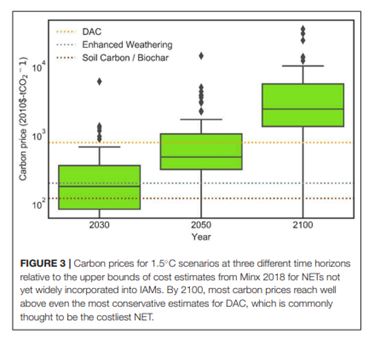Negative Emissions Technologies Modeling
Climate change mitigation strategies informed by Integrated Assessment Models (IAMs) increasingly rely on major deployments of negative emissions technologies (NETs) to achieve global climate targets. Although NETs can aid emissions mitigation efforts, this dependence on the presumed future ability to deploy NETs at scale raises questions about the structural elements of IAMs that are influencing our understanding of mitigation efforts. Model inter-comparison results underpinning the International Panel on Climate Change's special report on Global Warming of 1.5°C were used to explore the role that current assumptions are having on projections and the impact that emerging technologies, economic factors, innovation, and tradeoffs between negative emissions objectives and UN Sustainable Development Goals might have on future use of NETs.
The paper has three main findings: 1) there is a need to model more kinds of negative emissions technologies (NETs), 2) we need to understand how the economics of NETs will change with time and innovation; 3) we must consider the tradeoffs between NETs and sustainable development goals.

Current generation IAM scenarios widely assume we are capable of increasing the use of NETs over the coming 30 years to achieve negative emissions by predominantly relying on highly land-intensive NETs. Though the technological potential of some of these approaches (e.g., direct air capture) is much greater than for the land-based technologies, they are rarely included in the scenarios. Modeling results suggest that significant NET activity will be conducted in developing regions, raising concerns about tradeoffs with UN Sustainable Development Goals. These findings provide insight into how we might improve the treatment of NETs in IAMs to better inform international climate policy discussions. We emphasize the need to better understand the relative pros and cons of the full suite of NETs so that policymakers and stakeholders can be better informed.

An interdisciplinary effort by economists, environmental scientists, engineers, political scientists, and ethicists will be required to improve IAMs and the policies they are meant to inform if we are to avoid the worst damages of climate change.
For the full report, download the file below.


